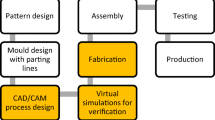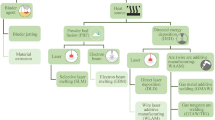Abstract
Hybrid moulds are an increasingly considered alternative for prototype series or short production runs. This type of tools resorts on the use of Rapid Prototyping and Tooling (RPT) to produce the moulding elements (blocks or other inserts). This study was developed using a hybrid injection mould with exchangeable moulding elements that were produced by additive manufacturing (AM), namely vacuum epoxy casting, stereolithography and ProMetal. A full steel tool was also used as a reference. The processing conditions for the polypropylene moulded parts using the hybrid mould were monitored for pressure, temperature and ejection force. The hybrid mould performance was assessed in terms of pressure and temperature evolution during the injection cycle and the AM moulding elements for physical integrity. The data from the polypropylene moulded parts and the moulding inserts are compared with structural and rheological simulations using ANSYS Workbench and MOLDEX 3D. The results show that the hybrid mould performance and the structural integrity of the moulding elements depend on the properties of the materials used. The moulding shrinkage, when resin cores are used, is also affected by the core deformation caused by the injection pressure.



















Similar content being viewed by others
Data availability
Not applicable
References
Campbell I, Combrinck J, Beer D, Barnard L (2008) Stereolithography build time estimation based on volumetric calculations. Rapid Prototyp J 14(5):271–279
Correia MS, Martinho PG, Pouzada AS (2014) The ejection force effect on the life of hybrid mould inserts produced by additive manufacturing. In: PMI 2014 - International conference on polymers and moulds innovations, Guimaraes, Portugal
Curfman WA (1989) Method of making an epoxy mold. General Motors Corporation, Detroit US Patent
Drizo A, Pegna J (2006) Environmental impacts of rapid prototyping: an overview of research to date. Rapid Prototyp J 12(2):64–71
Freitas A, Soares R, Martinho PG, Pouzada AS (2012) Rapid Prototyping and Tooling in the manufacture of mould elements for large parts. In: PMI 2012 - International conference on polymers and moulds innovations, Gent, Belgium
Godec D, Šercer M, Rujnic-Sokele M (2008) Influence of hybrid mould on moulded parts properties. Rapid Prototyp J 14(2):95–101
Gonçalves MW, Salmoria GV, Ahrens CH, Pouzada AS (2007) Study of tribological properties of moulds obtained by stereolithography. Virtual Phys Prototyp 2(1):29–36
Hopkinson N, Dickens P (2000) A comparison between stereolithography and aluminium injection moulding tooling. Rapid Prototyp J 6(4):253–258
Hou B, Huang Z, Zhou H, Li D (2018) A hybrid approach for automatic parting curve generation in injection mold design. Int J Adv Manuf Technol 95:3985–4001
Kruth JP, Mercelis P, Vaerenbergh JV, Froyen L, Rombouts M (2003) Advances in selective laser sintering. In: Advanced Research in Virtual and Rapid Prototyping, Leiria/Portugal
Marques S, Souza AF, Miranda J, Yadroitsau I (2015) Design of conformal cooling for plastic injection moulding by heat transfer simulation. Polímeros 25(6):564–574
Martinho PG, Bártolo PJ, Pouzada AS (2007) Efficient design solutions for hybrid moulds and the widening of the lifecycle of injection moulds. In: PMI 2007 - International conference on polymers and moulds innovations, Gent, Belgium
Martinho PG, Bártolo PJ, Pouzada AS (2009) Hybrid moulds: effect of the moulding blocks on the morphology and dimensional properties. Rapid Prototyp J 15(1):71–82
Martinho PG, Brito AM, Rodrigues SJ, Pouzada AS (2016) Hybrid moulds: the performance of moulding blocks produced by vacuum casting resins with different fillers. In: PMI 2016 - International conference on polymers and moulds innovations, Gent, Belgium
Martinho PG, Cardon L, Neves T, Bártolo PJ, Pouzada AS (2008) A study of the ejection forces on moulding inserts obtained by RPT techniques. In: RPD 2008 - International conference on rapid product development, Oliveira de Azeméis, Portugal
Mercado-Colmenero JM, Rubio-Paramio MA, Marquez-Sevillano J d J, Martin-Doñate C (2018) A new method for the automated design of cooling systems in injection molds. Comput Aided Des 104:60–86
Nogueira AA, Martinho PG, Brito AM, Pouzada AS (2013) Studies on the mouldability of structural foams in hybrid moulds. Adv Prod Eng Manag 8(2):134–142
Palma JM (1999) Metal spray tool repair system. The Boeing company, Seattle Wash.: US Patent
Pontes AJ, Queirós M, Bártolo PJ, Pouzada AS (2005) A study on design and performance of hybrid moulds for injection moulding. In: ICIT 2005 - 5th International Conference of Industrial Tools, Bled, Slovenia
Pouzada AS (2009) Hybrid moulds: a case of integration of alternative materials and rapid prototyping for tooling. Virtual Phys Prototyp 4(4):195–202
Pouzada AS, Ferreira EC, Pontes AJ (2006) Friction properties on moulding thermoplastics. Polym Test 25:1017–1023
Ribeiro AR Jr, Hopkinson N, Ahrens CH (2004) Thermal effects on stereolithography tools during injection moulding. Rapid Prototyp J 10(3):176–180
Sabino-Netto AC (2008) Desenvolvimento e avaliação de compósito de resina epóxi reforçado com fibras de aço na fabricação de blocos moldantes para moldagem por injeção. Universidade Federal de Santa Catarina, Florianópolis, Tese de Doutorado
Sabino-Netto AC, Salmoria GV, Ahrens CH, Pouzada AS (2008) Friction properties of steel fibre reinforced epoxy composites used in moulding blocks of hybrid moulds. Adv Mater Forum IV 587-588:217–221
Saurkar S, Malloy RA, McCarthy S (2005) Rapid tooling: a study of different cooling techniques for mold inserts used in the direct aim (ACES injection molding) process. In: Proceedings ANTEC 2005 International Conference, Boston, USA
Shojaefard MH, Goudarzi K (2008) The numerical estimation of thermal contact resistance in contacting surfaces. Am J Appl Sci 5(11):1566–1571
Silva EC, Sampaio AM, Pontes AJ (2018) Thermal performance of additive manufacturing in hybrid moulds. In: PMI 2018 - International conference on polymers and moulds innovations, Guimarães, Portugal
Author information
Authors and Affiliations
Contributions
Not applicable
Corresponding author
Ethics declarations
Conflict of interest
The authors declare that they have no conflict of interest.
Code availability
Not applicable
Additional information
Publisher’s note
Springer Nature remains neutral with regard to jurisdictional claims in published maps and institutional affiliations.
Rights and permissions
About this article
Cite this article
Martinho, P.G., Pouzada, A.S. Alternative materials in moulding elements of hybrid moulds: structural integrity and tribological aspects. Int J Adv Manuf Technol 113, 351–363 (2021). https://doi.org/10.1007/s00170-021-06630-5
Received:
Accepted:
Published:
Issue Date:
DOI: https://doi.org/10.1007/s00170-021-06630-5




